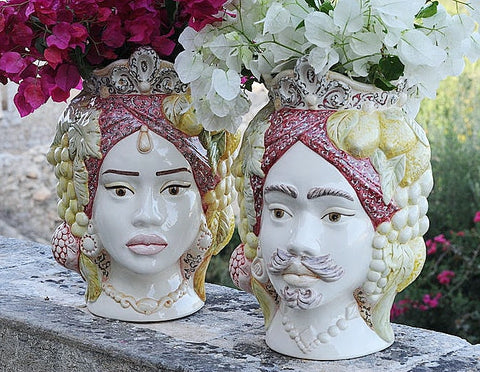A STORY OF ETERNAL LOVE
The Testa di Moro is a characteristic object of Sicilian tradition. It is a hand-painted ceramic vase used as an ornament depicting the face of a Moor and sometimes of a young woman of great beauty.
They are almost always displayed in pairs on the balconies of Sicilian houses, on the sides of sunlit terraces in country villas, but also as precious objects inside homes in cities across Italy and the world.
The Moor's Heads have today become an emblem of Sicily. They are liked by Sicilians, but also by all Italians and foreign tourists, who see in them a characteristic artistic expression of our land.
Today, the Testa di Moro is an increasingly appreciated design object. It is often of significant size, finely hand-painted, with a crown on the head and lavish jewelry around the neck.
The best production is distinguished by the brilliance of colors, refined color combinations, and the brightness of the ceramics, but also by the beauty of the face, the care and richness of details, the perfection of the features of the eyes and lips.
The Moorish Head is certainly linked to the period of Arab domination in Sicily, between the 9th and 12th centuries. Supporting this thesis are some of its characteristics: the facial features found in the oldest finds, very similar to those of the Arab population, and the decoration of the crown, which symbolizes the people who ruled at the time.
Anthropoid vases, those that recall in some of their parts or decorations the face or human torso, are of ancient origin.
Their use dates back to prehistoric times: archaeological finds demonstrate how the amphorae had necks decorated with simple incised lines representing the basic components of a face: eyebrows, eyes, and a hint of lips; while on the body of the vase, there were often two protrusions very similar to the shape of female breasts. From then on, ancient art is richly dotted with vases, sometimes decorative and other times for funerary use, whose volumes or decorations recall human or animal forms, as in the case of Egyptian civilization.
But what is the story of the Sicilian Moorish Heads? The true story of these objects, so unusual and fascinating, that tell us about a Sicily tied to its traditions, but also ready to innovate towards a very specific and at the same time original artistic creativity?
A legend tells that in a neighborhood of Palermo, the Kalsa, during the Arab occupation, there lived a beautiful girl. She spent her days taking care of the flowers on her balcony. A young Moor passed by who noticed her and one day decided to declare his love to her. They fell madly in love with each other. But unfortunately, he was married and had children, and to make matters worse, he had to leave. What did she do? She took a dagger and killed him in his sleep. Then, to ensure that he would always remain by her side, she cut off his head and used it as a vase for the basil. The basil, watered by the girl's tears, became lush and fragrant, so the ecstatic and envious neighbors began to make vases in the shape of a Moorish head.
Boccaccio also tells a similar story in the Decameron, that of the beautiful Lisabetta who falls in love with the young Lorenzo, of modest means. Her brothers then decide to assassinate him, but Lorenzo appears at night to his beautiful one and shows her where his body has been buried. Lisabetta then takes the head of her beloved and places it in a vase, where basil will grow. When her brothers take the vase from her, the young woman lets herself die, bringing an end to this unfortunate love story.
My emotion:
As a child, in the garden of my uncles' house in Palermo, adorning the entrance of the avenue covered by grapevines, there were succulent plants spilling out of red terracotta pots, shaped like Moorish heads. Every time I passed by, I looked at them with a mix of unease and fascination. It seemed to me that a form of life had crystallized in those strange objects and that at any moment the Moorish head could come to life and speak.
Save the collection of our Moorish Heads: https://emozioni-di-sicilia.com/collections/teste-di-moro


Leave a comment